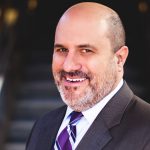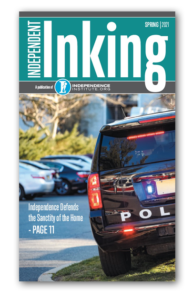INDEPENDENT INKING
Last year seemed like a major defeat for liberty in Colorado. In many ways, this is true. We are living in a captive state.
Progressives seized power and hold majorities in every statewide office while also controlling most large county and municipal governments. They also passed a paid family leave proposal which will be insolvent in a couple years, enacted a punishing nicotine tax, and dropped killer freakin’ wolves in other people’s backyards.
Last year also marked the year Independence Institute permanently shifted our strategy. For years, I’ve been saying that offense is the best defense, such as when we defeated the terrible infrastructure proposal of 2018 by putting our own on the ballot, called “Fix Our Damn Roads”. But for the most part, we have been forced to play defense against the Progressive machine that has swept away Colorado’s spirit of individual liberty. We won many victories and delayed the takeover of our beloved state, but now it’s time to truly go on offense.
When Progressives began their long term planning project of taking over Colorado, they were a small minority in the state. They spent decades building up their infrastructure to take over and transform the Colorado you and I loved. Now, it’s our turn. While not holding official power, we do have the power to change this circumstance.
Last year, you saw a sizeable test of this shift in strategy. We worked with our coalition partners to fight the attempt to abolish our Taxpayer’s Bill of Rights (TABOR) and our state’s flat income tax. The people of Colorado, while voting in a slew of Progressive candidates, heard our message and voted to support TABOR and permanently lower our flat income tax rate.
This year, Independence Institute is unveiling a multi-year strategy of offensive measures to retake our state. Unlike the Progressives, we already have the machinery in place to begin this offensive, and we are confident we can win. We have built the infrastructure to turn the tide.
We created a media empire that is larger than many of the legacy media outlets that pump out pro-Progressive propaganda they label as “news,” meaning we control our own narrative. Our 3 studios are capable of live-radio broadcasts, recording podcasts, producing high quality videos, and livestreaming interviews and urgent news on demand. No other organization in Colorado can claim this reach.
We are truly the Public Relations Firm for Liberty. Our media capacities allow this to happen, but Liberty is also a team sport. We bring our often-fractious Center Right Coalition together to strategize and organize on behalf of every Coloradan.
The fights we used to have out in the open (which often cost us victories) are now much less because of our tireless work to bring the groups who share a common cause if not a common vision together at our Freedom Embassy (our HQ) to create a better Colorado for everyone. This is how we managed to persuade everyday Coloradans to strengthen our TABOR and state’s flat income tax: because our coalition worked together.
While it takes time, we are confident that the foundation we have laid—victory by victory and coalition by coalition–is more than adequate to launch this next chapter of Independence Institute’s destiny.
Progressives aimed high and so will we. I am confident our new strategy will be the spark that sweeps aside their pernicious attack on our beloved state. While the future seems bleak now, I am confident that the best is yet to come.
Think Freedom,
What is making a difference in the lives of Colorado school children?
At Independence Institute’s Education Policy Center, we seek out exemplary education programs offered by Colorado public school districts. Since 2005 our reports have shone a light on what’s working in education so districts can replicate these unique programs for their own students. In recent years, we have expanded the series of research publications to include individual public school profiles. Colorado school district board members, legislators, principals, teachers, parents, and other community leaders have an opportunity to discover what Colorado educators are doing at the district and school level to help students succeed.
In January we published the third installation in our Colorado public schools profile series: Liberty Common Charter School: Excellence in Education. Education Senior Fellow Ross Izard captures the essence of one of Colorado’s most successful public schools as it inspires students even during the pandemic.
Liberty Common is an award winning K-12 public charter school authorized by the Poudre School District in Fort Collins, Colorado. The secret to its success is a strong curriculum, great teachers and leaders, and engaged parents and students. In the early grades, students receive explicit, systematic phonemic awareness and phonics instruction. Students in kindergarten through eighth grade are inspired by the content-rich Core Knowledge Sequence. The high school is a classically-oriented liberal arts college-preparatory institution that emphasizes math, science, and engineering. An important aspect of Liberty Common’s pursuit of excellence is its character education program.
The road to excellence was not an easy one. Former U.S. Congressman Bob Schaffer, the Headmaster of Liberty Common, his wife Maureen, and other parents in the Poudre School District, sought to open a “school of choice” even before Colorado had a charter school law. Wanting a rigorous, rich curriculum, they selected the Core Knowledge Sequence by Dr. E.D. Hirsch Jr., which instills a solid foundation of cultural literacy.
In spring 1993, about the same time the charter school law passed, the district approved a new Core Knowledge school as a district school with an independent governing board and the freedom to choose curricula. The new school was off to a good start. Unfortunately, a couple of years later, conflict developed between the school and the district. According to an historical account written by Dr. Maureen Schaffer, the district informed the parent-led board that it was taking over the hiring of faculty. The district immediately replaced two of the school’s teachers with tenured district teachers who needed placement.
The Schaffers and other concerned parents understood the importance of maintaining control over staffing to ensure high-quality instruction. They were determined to open a second new school, this time a charter school where they would have that essential liberty. To gain approval for a Core Knowledge charter school, founding parents had to fight difficult and expensive legal battles with the Poudre School District. Eventually, parents succeeded and opened Liberty Common School in the fall of 1997. The college-preparatory high school was added in 2010.
Today, Colorado’s public-school system boasts more than 260 charter schools offering a variety of educational programs statewide. Almost one-third of Colorado’s charter schools have implemented the popular Core Knowledge Sequence and/or a classical education program. New schools continue to open to accommodate the thousands of children who are on waitlists for some of the best schools in the state, like Liberty Common Charter School.
Enjoy reading Liberty Common Charter School: Excellence in Education. We promise you will be inspired by the school’s unique vision and the photographs of thriving students!
While the craziness of last year’s election has passed, Colorado Democrats are keeping the Fiscal Policy Center here at Independence Institute plenty busy.
Governor Polis and the state legislature are giddy over the improved budget forecasts that have been made since they passed the current year’s budget last June. Rather than seeing this as an opportunity to pay back the cash funds they raided last year, or save for the next rainy day, they’re stumbling over themselves searching for ways to spend the windfall. The Fiscal Policy Center is pushing back and challenging the Left’s narrative that higher taxes and more government will get the state back on the right path.
In his State of the State address in February, Polis proposed a $1 billion economic stimulus package on top of the emergency stimulus bill passed by the General Assembly in December and the trillions in federal stimulus funds. After a year of executive actions and mandatory closures of our economy that have left Coloradans flat on their faces, the governor proclaimed in his address that it’s now government’s job “to help folks get back on their feet.” At Independence Institute, we believe that too much government is the problem, and more government will not improve the state’s outlook.
The Fiscal Policy Center is monitoring what our elected officials are up to, how they’re spending taxpayer dollars, and how their policies have impacted the state’s residents. In a little noticed Joint Budget Committee (JBC) hearing, for example, legislators voted to increase funding by nearly $5 million for the Division of Housing, the state agency responsible for administering affordable housing programs. This may sound reasonable, but here’s where context is everything. The agency’s budget has ballooned from around $68 million to over $550 million due to state and federal pandemic-related stimulus funds. They have so much money to hand out, they can’t even keep up. As a result, the agency requested that the JBC reduce their funding by around $5 million in this year’s regular spending bill—and the committee said “no!” If the state has millions lying around to hand out to agencies who say they don’t need it, maybe they could fix our roads or lower taxes.
Unsurprisingly, things like this typically go entirely unnoticed, or at least unreported, by the mainstream press. If not for Independence Institute’s Fiscal Policy Center, another $5 million in waste would have flown under the radar. Keep an eye on the i2i.org Fiscal webpage and pagetwo.completecolorado.com for more out of our center.
Can police officers enter your home whenever they are engaged in “community caretaking”? In other words, can they enter without a search warrant, without probable cause of a crime? This question is presently before the U.S. Supreme Court.
In Caniglia v. Strom, the First Circuit Court of Appeals, which covers New England, said “yes” to warrantless home entries for community caretaking. The Supreme Court granted certiorari, and is making oral arguments on March 24. Independence Institute filed an amicus brief, defending the sanctity of the home.
The brief was co-authored by myself, Prof. George Mocsary of the University of Wyoming law school, and Joseph Greenlee of the Firearms Policy Coalition. More than any other brief, Independence Institute detailed the original meaning of the U.S. Constitution. Here’s a summary of the argument:
The sanctity of the home has been central to the idea of freedom since the Roman Republic, and it was cherished by Englishmen for centuries, leading up to the American Revolution. Embodied in the Castle Doctrine—the legal principle that “a man’s home is castle”—the inviolability of the home was celebrated by leading English legal authorities, including Edward Coke, William Hawkins, and William Blackstone. As William Pitt the Elder famously declared, even the poorest soul in the country had the right to defy the king in his own home.
But the English government nevertheless violated the sanctity of the home to seize property and to suppress speech, religion, assembly, political opposition, and firearm ownership. The English constantly complained about such infringements, but the violations continued.
American colonists, by contrast, had no tolerance for home intrusions. Violations of the home often resulted in hostility. American resistance to home invasions ultimately led to the American Revolution. According to John Adams, when James Otis delivered his fiery speech against writs of assistance (allowing British officials to search anywhere), American independence was born.
Many debates over the United States Constitution and the Bill of Rights focused on the need for robust and explicit protections for the home. Ultimately, the home became central to the Bill of Rights. The First through Fifth Amendments collectively create a zone of safety and protection in the home. Thus, the home has remained every American’s castle throughout all of American history.
The First Circuit’s decision, however, permits home intrusions whenever the officer acts “within the realm of reason” while executing community caretaking responsibilities. Such a standard would allow many of the home intrusions the founders vehemently opposed. Indeed, extending the community caretaking exception to the home would undermine the constitutional text, the Founders’ intent, and centuries of tradition.





